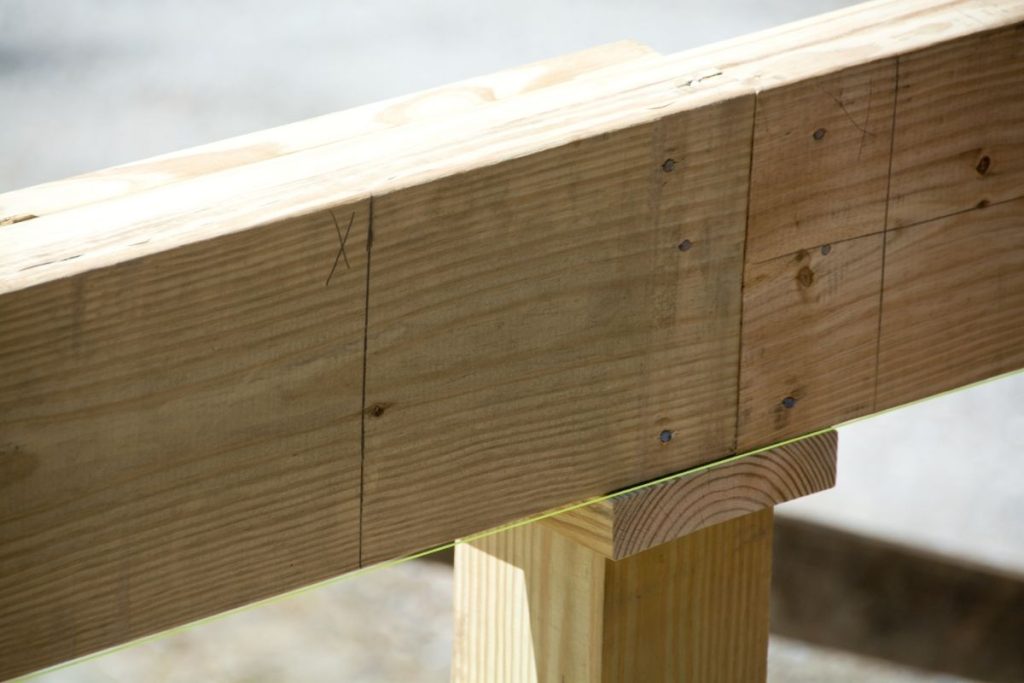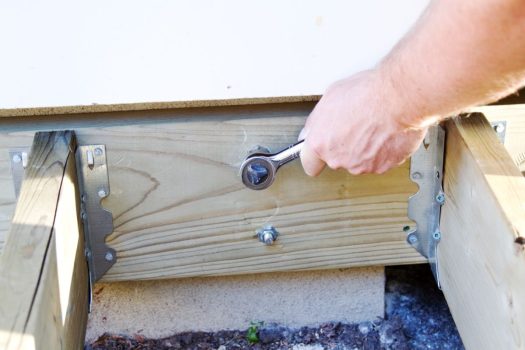Contents
If you are thinking about building a deck outside your home, you’ll need to consider what foundations you will use.
Deck foundations are, arguably, the most essential part of constructing a deck. Without appropriate foundations, your deck will not be structurally sound and may even be dangerous.
Choosing a type of foundation for your new deck isn’t as simple as choosing the most straightforward option or the one that seems most appealing. You’ll need to weigh the pros and cons and consider which type of foundation is likely to work best with the construction of your home.
Bearing this in mind, we’ll walk you through the four different types of deck foundations you can use to support your deck, along with the advantages and disadvantages of each type and instructions for installation.
Types Of Deck Foundations
Concrete Pillars (With Footings)
If your home is built on an area of problematic soil, you may want to consider choosing concrete pillar foundations with footings.
Footings, like the pillars, are usually made of concrete, and their purpose is to make it more difficult for the pillars to sink into the ground (this is called settling).
The advantages of this kind of foundation are that it’s a fairly permanent foundation, even on soil that tends to shift or have things sink into it. It’s also unlikely to be affected by extreme weather conditions such as frost.
Concrete pillars with footings can also be built on sloped ground, which is a major advantage because it can be difficult to build other foundations on the ground that is not completely flat.
Moreover, you can rely on concrete pillars with footings to support large decking areas without a problem.
The potential disadvantages of choosing concrete pillars with footings are that installing this kind of foundation takes a long time and costs a lot of money.
While concrete pillars with footings are resistant to frost, you’ll also need to dig far below the frost line to ensure this is the case, which is a laborious task.
Concrete Pillars (No Footings)
If installing concrete pillars with footings sounds like a lot of work and financial commitment, you might be able to use concrete pillars with no footings. However, you’ll need to ensure that the conditions around your home are suitable for this kind of foundation.
The advantages of building your deck on concrete pillars without footings are, for the most part, the same as those of concrete foundations with footings. They are a type of permanent foundation that can withstand frost. Most soil types are compatible with this kind of foundation, including sloping soil.
Unfortunately, just like concrete pillars with footings, you’ll need to dedicate a lot of time to this DIY project. The build will also involve a fair amount of digging because you will still need to get down below the frost line.
Additionally, while this foundation type works with most soils, if your soil is not compacted properly, your pillars will be more liable to sinking.
Concrete Base Blocks
Concrete base blocks are often considered to be the best foundation for decks that are not attached to buildings and areas that are not prone to frost.
Base blocks for decks are exactly what the name suggests: blocks made of concrete that help support decking, mostly to ensure that the deck stays even.
Concrete base blocks should work well if you are considering building a ground-level deck that isn’t attached to your home. As long as the soil underneath your decking is compact and you don’t deal with a lot of frost heave, this kind of foundation will prove long-lasting and easy to adjust if the ground has a mild slope.
Sadly, if you get a lot of frost in your area or your soil doesn’t drain very well, concrete base blocks will shift easily. This is partly why this kind of foundation is not recommended if you’re building a deck attached to your home.
Posts / Screw Piles
Your final option for deck foundations is to use a combination of posts and screw piles.
Screw piles are anchoring systems that allow posts to be driven very deep into the ground, ensuring longevity and immovability. The posts are installed into the screw piles, providing a firm and reliable deck foundation.
There are many advantages to choosing posts with screw piles as a foundation for your deck. For one thing, this foundation works with virtually any kind of soil. The only exception is where the ground under the deck is extremely rocky, in which case, it can be very difficult to drive the screw piles and posts all the way down.
Posts and screw piles are usually made of stainless steel, which means that they are corrosion-resistant and, therefore, less likely to be structurally damaged by moisture in the soil.
Because screw piles and posts are driven deep down into the ground, you can enjoy the peace of mind of knowing that your deck foundation isn’t going anywhere.
However, the fact that this foundation needs to be installed so deep into the ground, underneath the frost line, comes with its own disadvantages. Although posts and screw piles are relatively easy to install if you have specialist equipment, most people do not have access to such equipment or the requisite knowledge to use it properly.
Therefore, you’ll probably need to hire a professional to conduct this installation for you if you want solid, safe, and long-lasting results.
How To Install Deck Foundations

Installing Concrete Pillars (With Footings)
Concrete pillars with footings are quite time-consuming and challenging to install, but if you have the time and energy, here’s how to get the job done.
The first step is to work out how heavy your decking will be so that you can determine how many pillars will be needed. Get a professional opinion on this if you can, just to be sure.
Then, you need to clear around 4 inches around where the decking will go.
Once you’ve found the right positioning for your pillars, it’s time to dig the holes for the pillars. The holes should be 54 inches deep, with enough room for forms measuring 24 inches. The forms should be square and, ideally, made of boards measuring 8 by 2 inches.
Next, position a rod and wire for reinforcement diagonally, with an L-shaped reinforcement rod in the middle of the frame. Make sure the shorter end is tucked under the diagonal rod. This way, the L-shaped rod will connect the pillar to the footing.
Now, pour in the concrete while holding the rod in place and let it cure before putting form tubes in the middle of the footing with wooden pieces to provide extra support.
Once the tubes are level, make sure the foundation is perfectly square before backfilling the footing and filling the form tubes with concrete.
Take some saddle spikes and put them in the middle of each pillar, allowing 1 inch at the surface. When saddle spikes are level, put concrete in mounds around the post so that any excess water drains away. Repeat the process for all the pillars.
Installing Concrete Pillars (Without Footings)
Start this process the same way you would for concrete pillars with footings: calculate your total deck weight and clear 4 inches around the deck.
Mark the deck perimeter with string and work out where your pillars will go. The external edges of the timbers should be level with the string.
Take a pothole auger and start digging holes for the pillars. They should be between 10 and 12 inches in diameter and 54 inches in depth.
Put about 6 inches of rocks into the bottom of each hole so that the soil can drain. Place a form tube in every hole as well, securing them in place with wooden supports.
After ensuring your foundation is square, backfill the tubes on the outside and place a steel rod into each tube, having secured the tubes.
Place saddle spikes in every tube, leaving an inch at the top and making sure they’re all the same height. Create concrete mounds surrounding the post for drainage and repeat.
Installing Concrete Base Blocks
To install concrete base blocks, start by clearing a 4-inch perimeter. Next, after figuring out where your blocks will be positioned, dig the holes for the blocks.
These holes should be 12 inches deep and 24 square inches. The holes will need to be filled with 3 4-inch layers of gravel. You will need a mechanical compactor or vibrating plate to make sure the layers are compact.
Cover the cleared surface with a geotextile sheet and position your blocks. Make sure all the blocks sit at the same level. If they don’t, you’ll need to remove blocks that are too tall and take out some of the gravel. Alternatively, add more gravel to blocks that sit too low.
Backfill the rest of the space within the perimeter with gravel, and your foundations will be ready.
Installing Posts And Screw Piles
You should always hire a professional to install posts and screw piles for your deck foundation. This is because professionals have access to specialized tools.
The professional you hire to build the foundations will start by working out where the screw piles will go.
Using a hydraulic pile driver to drive the screw anchor into the soil. Then, having made the proper realignments, they will compact the soil around the bottom of the screw pile and insert the post. This process will be repeated until each screw pile and post is inserted.
Final Thoughts
When it comes to choosing a type of foundation for your deck, you have four options: concrete pillars complete with footings, concrete pillars with no footings, concrete blocks, or screw piles and posts.
Each of these options has advantages and disadvantages, so choosing the right one for your deck will involve weighing up the condition of the ground under the deck perimeter, how much the ground is sloping, and whether your deck will be attached to your home.
Three out of four of these foundation types can be built using DIY measures. However, posts and screw piles need to be installed by a professional, and it’s always best to check things like measurements and weights with a professional if possible.







